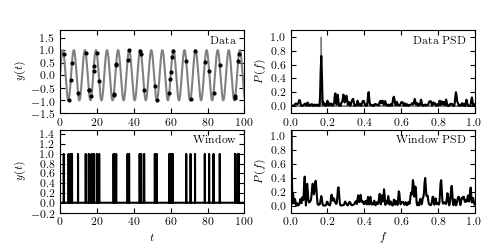The effect of Sampling¶
Figure 10.4
An illustration of the impact of a sampling window function of resulting PSD. The top-left panel shows a simulated data set with 40 points drawn from the function y(t|P) = sin(t) (i.e., f = 1/(2pi) ~ 0.16). The sampling is random, and illustrated by the vertical lines in the bottom-left panel. The PSD of sampling times, or spectral window, is shown in the bottom-right panel. The PSD computed for the data set from the top-left panel is shown in the top-right panel; it is equal to a convolution of the single peak (shaded in gray) with the window PSD shown in the bottom-right panel (e.g., the peak at f ~ 0.42 in the top-right panel can be traced to a peak at f ~ 0.26 in the bottom-right panel).

# Author: Jake VanderPlas
# License: BSD
# The figure produced by this code is published in the textbook
# "Statistics, Data Mining, and Machine Learning in Astronomy" (2013)
# For more information, see http://astroML.github.com
# To report a bug or issue, use the following forum:
# https://groups.google.com/forum/#!forum/astroml-general
import numpy as np
from matplotlib import pyplot as plt
#----------------------------------------------------------------------
# This function adjusts matplotlib settings for a uniform feel in the textbook.
# Note that with usetex=True, fonts are rendered with LaTeX. This may
# result in an error if LaTeX is not installed on your system. In that case,
# you can set usetex to False.
if "setup_text_plots" not in globals():
from astroML.plotting import setup_text_plots
setup_text_plots(fontsize=8, usetex=True)
#------------------------------------------------------------
# Generate the data
Nbins = 2 ** 15
Nobs = 40
f = lambda t: np.sin(np.pi * t / 3)
t = np.linspace(-100, 200, Nbins)
dt = t[1] - t[0]
y = f(t)
# select observations
np.random.seed(42)
t_obs = 100 * np.random.random(40)
D = abs(t_obs[:, np.newaxis] - t)
i = np.argmin(D, 1)
t_obs = t[i]
y_obs = y[i]
window = np.zeros(Nbins)
window[i] = 1
#------------------------------------------------------------
# Compute PSDs
Nfreq = int(Nbins / 2)
dt = t[1] - t[0]
df = 1. / (Nbins * dt)
f = df * np.arange(Nfreq)
PSD_window = abs(np.fft.fft(window)[:Nfreq]) ** 2
PSD_y = abs(np.fft.fft(y)[:Nfreq]) ** 2
PSD_obs = abs(np.fft.fft(y * window)[:Nfreq]) ** 2
# normalize the true PSD so it can be shown in the plot:
# in theory it's a delta function, so normalization is
# arbitrary
# scale PSDs for plotting
PSD_window /= 500
PSD_y /= PSD_y.max()
PSD_obs /= 500
#------------------------------------------------------------
# Prepare the figures
fig = plt.figure(figsize=(5, 2.5))
fig.subplots_adjust(bottom=0.15, hspace=0.2, wspace=0.25,
left=0.12, right=0.95)
# First panel: data vs time
ax = fig.add_subplot(221)
ax.plot(t, y, '-', c='gray')
ax.plot(t_obs, y_obs, '.k', ms=4)
ax.text(0.95, 0.93, "Data", ha='right', va='top', transform=ax.transAxes)
ax.set_ylabel('$y(t)$')
ax.set_xlim(0, 100)
ax.set_ylim(-1.5, 1.8)
# Second panel: PSD of data
ax = fig.add_subplot(222)
ax.fill(f, PSD_y, fc='gray', ec='gray')
ax.plot(f, PSD_obs, '-', c='black')
ax.text(0.95, 0.93, "Data PSD", ha='right', va='top', transform=ax.transAxes)
ax.set_ylabel('$P(f)$')
ax.set_xlim(0, 1.0)
ax.set_ylim(-0.1, 1.1)
# Third panel: window vs time
ax = fig.add_subplot(223)
ax.plot(t, window, '-', c='black')
ax.text(0.95, 0.93, "Window", ha='right', va='top', transform=ax.transAxes)
ax.set_xlabel('$t$')
ax.set_ylabel('$y(t)$')
ax.set_xlim(0, 100)
ax.set_ylim(-0.2, 1.5)
# Fourth panel: PSD of window
ax = fig.add_subplot(224)
ax.plot(f, PSD_window, '-', c='black')
ax.text(0.95, 0.93, "Window PSD", ha='right', va='top', transform=ax.transAxes)
ax.set_xlabel('$f$')
ax.set_ylabel('$P(f)$')
ax.set_xlim(0, 1.0)
ax.set_ylim(-0.1, 1.1)
plt.show()
